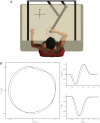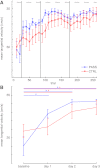Can proprioceptive training improve motor learning?
- PMID: 22972960
- PMCID: PMC3544879
- DOI: 10.1152/jn.00122.2012
Can proprioceptive training improve motor learning?
Abstract
Recent work has investigated the link between motor learning and sensory function in arm movement control. A number of findings are consistent with the idea that motor learning is associated with systematic changes to proprioception (Haith A, Jackson C, Mial R, Vijayakumar S. Adv Neural Inf Process Syst 21: 593-600, 2008; Ostry DJ, Darainy M, Mattar AA, Wong J, Gribble PL. J Neurosci 30: 5384-5393, 2010; Vahdat S, Darainy M, Milner TE, Ostry DJ. J Neurosci 31: 16907-16915, 2011). Here, we tested whether motor learning could be improved by providing subjects with proprioceptive training on a desired hand trajectory. Subjects were instructed to reproduce both the time-varying position and velocity of novel, complex hand trajectories. Subjects underwent 3 days of training with 90 movement trials per day. Active movement trials were interleaved with demonstration trials. For control subjects, these interleaved demonstration trials consisted of visual demonstration alone. A second group of subjects received visual and proprioceptive demonstration simultaneously; this group was presented with the same visual stimulus, but, in addition, their limb was moved through the target trajectory by a robot using servo control. Subjects who experienced the additional proprioceptive demonstration of the desired trajectory showed greater improvements during training movements than control subjects who only received visual information. This benefit of adding proprioceptive training was seen in both movement speed and position error. Interestingly, additional control subjects who received proprioceptive guidance while actively moving their arm during demonstration trials did not show the same improvement in positional accuracy. These findings support the idea that the addition of proprioceptive training can augment motor learning, and that this benefit is greatest when the subject passively experiences the goal movement.
Figures









Similar articles
-
Spatially selective enhancement of proprioceptive acuity following motor learning.J Neurophysiol. 2011 May;105(5):2512-21. doi: 10.1152/jn.00949.2010. Epub 2011 Mar 2. J Neurophysiol. 2011. PMID: 21368000 Free PMC article. Clinical Trial.
-
Force field adaptation can be learned using vision in the absence of proprioceptive error.IEEE Trans Neural Syst Rehabil Eng. 2011 Jun;19(3):298-306. doi: 10.1109/TNSRE.2011.2125990. IEEE Trans Neural Syst Rehabil Eng. 2011. PMID: 21652280
-
Proprioceptive loss and the perception, control and learning of arm movements in humans: evidence from sensory neuronopathy.Exp Brain Res. 2018 Aug;236(8):2137-2155. doi: 10.1007/s00221-018-5289-0. Epub 2018 May 19. Exp Brain Res. 2018. PMID: 29779050 Free PMC article.
-
Plastic changes in hand proprioception following force-field motor learning.J Neurophysiol. 2010 Sep;104(3):1213-5. doi: 10.1152/jn.00543.2010. Epub 2010 Jul 7. J Neurophysiol. 2010. PMID: 20610787 Free PMC article. Review.
-
Visuomotor adaptation and proprioceptive recalibration.J Mot Behav. 2012;44(6):435-44. doi: 10.1080/00222895.2012.659232. J Mot Behav. 2012. PMID: 23237466 Review.
Cited by
-
On the evolution of handedness: evidence for feeding biases.PLoS One. 2013 Nov 13;8(11):e78967. doi: 10.1371/journal.pone.0078967. eCollection 2013. PLoS One. 2013. PMID: 24236078 Free PMC article.
-
Fast learning without synaptic plasticity in spiking neural networks.Sci Rep. 2024 Apr 12;14(1):8557. doi: 10.1038/s41598-024-55769-0. Sci Rep. 2024. PMID: 38609429 Free PMC article.
-
Short-Term Reproduction of Active Movement with Visual Feedback and Passive Movement with a Therapist's Hands.Brain Sci. 2024 May 23;14(6):531. doi: 10.3390/brainsci14060531. Brain Sci. 2024. PMID: 38928531 Free PMC article.
-
Passive training with upper extremity exoskeleton robot affects proprioceptive acuity and performance of motor learning.Sci Rep. 2020 Jul 16;10(1):11820. doi: 10.1038/s41598-020-68711-x. Sci Rep. 2020. PMID: 32678206 Free PMC article.
-
Training compliance control yields improved drawing in 5-11year old children with motor difficulties.Hum Mov Sci. 2016 Aug;48:171-83. doi: 10.1016/j.humov.2016.05.006. Epub 2016 May 21. Hum Mov Sci. 2016. PMID: 27219739 Free PMC article.
References
-
- Brooke JD, Cheng J, Collins DF, McIlroy WE, Misiaszek JE, Staines WR. Sensori-sensory afferent conditioning with leg movement: gain control in spinal reflex and ascending paths. Prog Neurobiol 51: 393–421, 1997 - PubMed
-
- Brown LE, Wilson ET, Gribble PL. Repetitive transcranial magnetic stimulation to the primary motor cortex interferes with motor learning by observing. J Cogn Neurosci 21: 1013–1022, 2009 - PubMed
Publication types
MeSH terms
Grants and funding
LinkOut - more resources
Full Text Sources
Other Literature Sources
Medical

